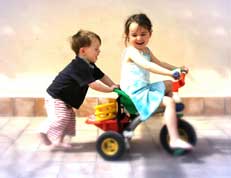Case Study

Adam 24 months old
Background
Adam’s mom went back to work fulltime when Adam was four months old. She had found a family daycare home near her house and Adam was very happy there as an infant. When he was twelve months old, a space opened up at the child care center sponsored by his mom’s company, so she moved him into the toddler room there. This arrangement was very convenient for her and Adam seemed to really like the larger space and wider range of play activities. Then, when he turned 22 months old, he was moved into the two year old room; an opening had come up and he was next on the list, so he was moved up early, before actually turning two.
One day, Adam’s mom got a report from his caregiver that he had bitten another child in his group. She immediately phoned Adam’s pediatrician who assured her that this was normal behavior for a toddler and that the child care staff should be able to handle it easily. However, each day the caregivers reported several biting episodes, always taking place in the morning and always outside on the playground. Adam’s parents became very defensive, convinced that Adam had learned this behavior at the center. They simply couldn’t understand why the teachers couldn’t intervene in time. The doctor had said biting was normal, but the child care staff seemed unable to stop it from happening. Communications became very strained between the mother and the center. After about a month of this, the parents were informed that they should begin looking for “alternate placement”. The next day, after Adam bit the daughter of his mom’s colleague, Adam’s mom reached out for my professional help. After meeting with the mom, the staff, and observing Adam at the center, here are my findings, below.
-
- Stage of Development: Adam was a healthy, average-sized toddler. He usually had some difficulty in separating from his mother in the mornings, but after she left, he happily settled in to play with his favorite toys. He had a strong preference for small motor toys, such as manipulatives, rather than large motor toys, such as bikes and balls. Most of the time, he played comfortably alongside other children in parallel play, as would be expected of a toddler.
- Previous Experiences and Recent Changes: Adam had never been the recipient of a bite at home or at the child care program, but he had seen other people getting bitten. Recently, Adam’s dad had begun traveling a lot for his job, sometimes being gone for two weeks at a time. Adam’s mom didn’t like to be alone at night, so she had been letting Adam stay up late watching TV with her. He often fell asleep on the couch about 10 pm. She rationalized this by saying that “he got plenty of sleep” since he napped every afternoon at the child care center. Another recent change for Adam was related to his move to the two year old room, which had different policies than an infant/toddler room. Adam used to drink a full bottle in the toddler room twice a day. But now that he was in the two year old room, he had to abide by the ‘no bottle’ policy.
- Speech and Language Skills: Adam had very limited verbal skills. While he could understand what adults said to him and could comply with their requests, he had a hard time articulating his own needs. His speech was very unclear, hard to decipher by adults and children alike, and he stuttered occasionally.
- Physical Condition: He had never had any ear infections and appeared to have no hearing problems. His teething patterns were normal, with typical eruptions. He ate breakfast in the morning at the child care program, and he had a big lunch at lunchtime. He was an oral child, putting his fingers in his mouth a lot during the day. Adam was always exhausted by naptime, falling asleep as soon as he lay down on his cot, napping for two and one-half hours each day.
- Temperament Traits: Adam was not a particularly active child. He didn’t like climbing and running. He was more sedentary, content to sit and look at books, use paints, or play with peg boards and puzzles. Adam didn’t show much facial expression regarding his feelings; his “affect” was very mild, making him hard for people “to read”. He was described as a serious child, not exactly negative but not positive, either.
- The Environment: The two year old classroom was a comfortable and soothing yet stimulating place to spend time. It was adequately-sized and rich in a wide variety of age appropriate and challenging materials. By contrast, the playground was not well-equipped. There weren’t enough play spaces and there wasn’t enough variety. There were no small motor activities set up to augment the large motor items. The playground consisted mainly of a large climbing structure on rubber mat, assorted riding toys, and a large sandbox. There were no benches for adults or children to sit. There were no painting easels or chalk drawing areas. There wasn’t any grass for relaxing in the shade to look at books or playing with dolls. There weren’t any tables set up for playing with bubble-making fluids or building with small blocks. All in all, the playground was sparse. Children were expected to play out there for an hour before lunchtime.
- Limit Setting Strategy: At home, Adam ruled the roost. He was an only child of two older parents (who did not plan on having any more children). His parents were very “conflict adverse”, opposed to any kind of confrontation so they let Adam do as he pleased. Their solution to any kind of fussy behavior or tantrum was to offer him a bottle so he would calm down. They reported giving Adam an average of eight bottles per day on the weekends and two or three bottles on weekday evenings. Adam’s parents were at a loss about what to do on the home front regarding biting, since he never bit them. When they got him home in the evening, they tried to reason with him, asking him to be nice to his friends, saying it “made mommy sad when he bit people.” Regarding limit setting at the child care program, the current staff had various levels of expertise in handling misbehavior, so they were inconsistent in how they responded to biting. Children got mixed messages, depending on who stepped in to deal with the conflict at the time. Mostly, they used a mixture of lecturing and scolding when he bit someone. Lately, the teachers had started sending him to the director’s office when he bit, to remove him from the yard altogether. When they plopped him down in the director’s office they said, “It’s not nice to bite people, Adam. You have to sit here and think about that.” Needless to say, this approach did not have the desired effect.

Adam’s biting was not his fault; it was being caused by things the adults were doing at home and in the child care center. For months, he had been allowed to constantly use a bottle to relieve any type of stress at home, and it created a tendency for him to respond to typical daily stressors at the center orally, through biting.
His verbal skills were minimal, partially due to overall lack of rich language experiences offered to him both at home and at the center. The adults in his life needed new and better ideas for promoting new verbal skills.
Regarding emotional development, Adam wasn’t learning any new skills for dealing with his frustration, given the inadequate limit setting practices provided by his caregivers.
Interestingly, his biting only occurred in the morning on the playground, where play materials were inadequate and less teachers were available to supervise, due to lunchtime prep.
As it turned out, there were many practical ways in which the adults could immediately make changes and intervene more effectively, to help Adam stop biting.
- Stage of Development:
- Emotional Development - Adam had been using bottles to address his emotional needs. At home, Adam was allowed to solve his fussiness with oral satisfaction by using bottles constantly. He had not been learning any other means of dealing with life other than to block it out with a bottle.
- As soon as he was transferred to the two year old room, he had to suddenly give up his daytime bottles, leaving him at a loss of how to deal with stress, frustration or disappointment. He started biting soon after this major change to his lifestyle.
- So, while the parents taught him new ways to deal with frustration, they also began to limit the number of bottles he got at home. They distracted him from his desire to have a bottle by offering him a pacifier or a washcloth or a rubber toy to chew on. They spent focused time with him doing household things together or playing on the floor with his toys. They found new ways to spend time together such as singing songs, reading books, taking walks, and playing with play dough.
- They planned to fully wean him from the bottle within a month at the latest. Ideas included: limiting the use of the two remaining bottles to certain locations in the house, using shorter bottles, diluting the milk with water, giving only bottles with water, providing alternate types of containers, and drinking milk together with their child using cups. In a few weeks, the plan was to gather up all the bottles, put them in a box, and send them to “the babies who need them”. Letting go of the bottles helped Adam become more autonomous, to see himself as a big boy, not a baby.
- Social Development - Adam needed specific help in learning to interpret the feelings and intentions of other people. The parents and teachers promoted empathy by finding ways for Adam to show “caring”, i.e., feeding the cat, watering the plants, bringing someone a bandage or ice for a hurt, rubbing mom’s back, etc. They commented on people’s feelings in everyday situations, i.e., “I see a little baby crying in his stroller. He feels sad about something. I wonder if he is hungry.”
- The caregivers tried sitting near the play areas and acting as a commentator on the children’s activities to help them learn to decipher the situation and to teach pro-social behavior. “I see John and Brent using the red blocks together. Very nice, boys!” or “Brady found a ball for Tracy and gave it to her. That was sweet!”
- The parents promoted turn-taking behavior by using “turn” terminology at home whenever possible, i.e., “It is my turn with the hairbrush. Do you want the next turn?”
- Past Experiences and Recent Changes:
- Adam was constantly tired, so the parents realized the importance of maintaining a more normal sleep schedule for Adam. Keeping him up past a two year old’s normal bedtime was interfering with his ability to take full advantage of the morning’s activities at child care. By 10:30 am every morning, he had begun to get really tired and had a harder time coping with the normal stressors of being around a group of children without resorting to grabbing and biting.
- Adam’s mom got more specific ideas from me on how to get him to bed at night, especially when she was on her own.
- Verbal Skills:
- Having a bottle in his mouth all evening and weekend was interfering with Adam’s speech and language development.
- He needed focused help to learn new verbal skills so that he could interact with other children more successfully. His parents began to read to him as much as possible, so he could hear the flow of their language in context with the pictures in the story. They paused a lot and made it a very interactive experience. They talked about the feelings of the characters in the stories.
- Both parents and teachers began using “Extension” with Adam’s language when he used one-word sentences. When Adam pointed to the crackers and said, “More!” they said, “Sounds like you want some more of those cute little square crackers. Here you go…. more crackers for Adam.” They didn’t ask him to repeat the extension, they just let him hear the word, expanded into sentences.
- Both parents and teachers began using “self-talk” to describe their actions during daily life. They modeled for him how sentences are put together. “The water on this floor is really making the floor slippery. I am going to wipe it up. Do you want to help me?”
- The teachers started to encourage Adam to use specific phrases in potential confrontations when interacting with children, such as: my turn, don’t push, my seat, I want that, help me, hurry up, stop that, please, etc. With an assortment of verbal tools at the tip of his tongue, he was better able to curb his misbehavior in a tense situation.
- Physical Condition: No recommendations for this area
- Temperament Traits
- Because Adam didn’t show a lot of emotion in his face, it was more difficult to know what he was feeling. Teachers stopped assuming that he didn’t care about something because his reaction were of low intensity; his expression of all emotion was of low intensity.
- Adam was a very persistent child, and parents knew that they would have to stick to their limits in order to teach him new behaviors at home. Adam’s mom, who tended to be much less persistent in her temperament, realized that this would be especially difficult for her.
- The parents started to help Adam learn patience by helping him to see the rationale when they didn’t jump to his demands immediately. They started giving him a concrete explanation why he couldn’t have what he wanted right away. They said, “My hands are busy fixing lunch right now, Adam. I’ll come over and play that game with you when my hands are all done with this.” This kind of explanation defined their availability in a more recognizable way, allowing Adam to feel more patient.
- The Environment
- Since the playground was under-equipped, the teachers counted the total number of play spaces available to the toddlers and kept adding items until they had provided 24 two year olds with 36 play spaces outdoors. Having enough play spaces allowed children to have “choices” during the day, lessoning their impulse to snatch items from each other, i.e., the musical chairs effect of an under-equipped setting.
- The only types of play available to the children on the playground had been activities that involved running, riding, and climbing. Bringing “loose parts” materials out of doors meant extra clean-up for the caregivers but it paid off in a happier, well-occupied group of children, especially those young twos who preferred to play on their own, or with small motor activities. The teachers provided tables for the staging of activities such as art or manipulatives. They added a large, empty plastic wading pool to create a soft spot to sit on pillows and look at books, kind of like an outdoor “nest”. Also, the teachers started letting the children paint with water on the walls of the school and the concrete walkway, using large paint brushes and buckets of water.
- Limit Setting Practices
- At home, Adam’s mom and dad needed to work on developing ways of setting limits with Adam in ways that were firm and clear, without being so tentative and apologetic. Adam’s mom realized that as he moved into the next phase of his development, he would exhibit more oppositional behavior and she would need to be prepared for him to push her limits on a regular basis. Even though he was not biting at home, Adam needed to know where his boundaries were, in all types of negative behaviors. Parent education or short term counseling was suggested to her as a useful adjunct to The Action Plan Worksheet.
Conclusion
The staff at the child care center had not known that Adam was getting eight bottles a day on the weekends. The parents had not seen the connection between non-stop bottles at home and Adam’s dealing with stress at child care through oral means, such as biting. As soon as both parties understood this fact, they began a fruitful conversation about how to help Adam with weaning and in learning verbal tools and self-comforting techniques to replace his bottle habit. The parents stopped blaming the center for Adam’s biting and the center purchased some new items for the playground that benefitted all of the two year olds. The teachers began using the new, clearer responses to biting and attempts at biting. They found that this problem solving method was useful for all sorts of conflicts on the playground and in the classroom. In less than two weeks, Adam’s biting was a thing of the past!
